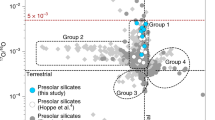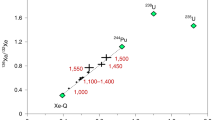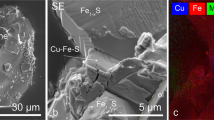Abstract
Recent mineralogical and geochemical studies of interplanetary dust particles (IDPs) provide convincing evidence that they contain materials that formed in the early solar nebula. Some chondritic IDPs contain hydrated phases and may be related to CI and CM carbonaceous chondrites. However, detailed mineralogical data of the hydrated IDPs are extremely limited. We report here the results of transmission electron microscope (TEM) observations of a hydrated IDP containing Fe-, Mg-rich smectite or mica as a major phase. The sheet silicate appears to have formed by alteration of anhydrous silicates. Fassaite, a Ca, Al clinopyroxene, also occurs in this particle, and one of the crystals exhibits solar-flare tracks, clearly indicating that it is extraterrestrial. Fassaite is a major constituent of the Ca-, Al-rich refractory inclusions (CAIs) found in the carbonaceous chondrites. Its presence in this particle, therefore, suggests that there may be a link between hydrated IDPs and carbonaceous chondrites in the early history of the Solar System.
This is a preview of subscription content, access via your institution
Access options
Subscribe to this journal
Receive 51 print issues and online access
$199.00 per year
only $3.90 per issue
Buy this article
- Purchase on Springer Link
- Instant access to full article PDF
Prices may be subject to local taxes which are calculated during checkout
Similar content being viewed by others
References
Sandford, S. A., Fraundorf, P., Patel, R. & Walker, R. M. Meteoritics 17, 276–277 (1982).
Zinner, E. & McKeegan, K. D. Lunar planet. Sci. 15, 961–962 (1984).
Zinner, E., McKeegan, K. D. & Walker, R. M. Nature 305, 119–121 (1983).
Cliff, G. & Lorimer, G. W. J. Microsc. 103, 203–207 (1975).
Tomeoka, K. & Buseck, P. R. Earth planet. Sci. Lett. 69, 243–254 (1984).
Brownlee, D. E. in Protostars and Planets (ed. Gehrels, T.) 134–150 (University of Arizona Press, 1978).
Deer, W. A., Howie, R. A. & Zussman, J. in Rock Forming Minerals Vol. 2A, 399–414 (Wiley, New York, 1978).
Clarke, R. S. et al. Smithson. Contr. Earth Sci. 5, 1–53 (1970).
Grossman, L. Geochim. cosmochim. Acta 39, 433–454 (1975).
Macdougall, J. D. Earth planet. Sci. Lett. 42, 1–6 (1979).
MacPherson, G. J., Bar-Matthews, M., Tanaka, T., Olsen, E. & Grossman, L. Geochim. cosmochim. Acta 47, 823–839 (1983).
Bischoff, A. & Keil, K. Nature 303, 588–592 (1983).
Bischoff, A. & Keil, K. Geochim. cosmochim. Acta 48, 693–709 (1984).
Bradley, J. P., Brownlee, D. E. & Fraundorf, P. Science 226, 1432–1434 (1984).
Fraundorf, P., Flynn, G. J., Shirck, J. & Walker, R. M. Proc. 11th Lunar. planet. Sci. Conf., 1235–1249 (1980).
Iijima, S. & Buseck, P. R. Am. Miner. 60, 758–770 (1975).
Buseck, P. R. & Iijima, S. Am. Miner. 60, 771–784 (1975).
Christoffersen, R. & Buseck, P. R. Lunar planet. Sci. 15, 152–153 (1984).
Bradley, J. P., Brownlee, D. E. & Veblen, D. R. Nature 301, 473–477 (1983).
Veblen, D. R. & Buseck, P. R. Am. Miner. 66, 1107–1134 (1981).
Eggleton, R. A. & Boland, J. N. Clay Clay Miner. 30, 11–20 (1982).
Tomeoka, K. & Buseck, P. R. Nature 299, 327–329 (1982).
Yada, K. & Iishi, K. Am. Miner. 62, 958–965 (1977).
Fuchs, L. H., Olsen, E. & Jensen, K. J. Smithson. Contr. Earth Sci. 10, 1–39 (1973).
Tomeoka, K. & Buseck, P. R. Nature 306, 354–356 (1983).
DuFresne, E. R. & Anders, E. Geochim. cosmochim. Acta 26, 1085–1114 (1962).
Nagy, B., Meinschein, W. G. & Hennessy, D. J. Ann. N.Y. Acad. Sci. 108, 534–552 (1963).
Boström, K. & Fredriksson, K. Smithson. Misc. Collect. 151, 1–39 (1966).
Bunch, T. E. & Chang, S. Geochim. cosmochim. Acta 44, 1543–1577 (1980).
McSween, H. Y. Geochim. cosmochim. Acta 43, 1761–1770 (1979).
Brownlee, D. E. Rev. Geophys. Space Phys. 17, 1735–1743 (1979).
Gaffey, M. J. & McCord, T. B. in Comets, Asteroids, Meteorites (ed. Delsemme, A. H.) 199–218 (University of Toledo Press, 1977).
Yoder, H. S. & Tilley, C. E. J. Petrol. 3, 342–532 (1962).
Author information
Authors and Affiliations
Rights and permissions
About this article
Cite this article
Tomeoka, K., Buseck, P. Hydrated interplanetary dust particle linked with carbonaceous chondrites?. Nature 314, 338–340 (1985). https://doi.org/10.1038/314338a0
Received:
Accepted:
Issue Date:
DOI: https://doi.org/10.1038/314338a0
This article is cited by
-
Meteoritic materials within sulfate aerosol particles in the troposphere are detected with transmission electron microscopy
Communications Earth & Environment (2022)
-
Spectrally blue hydrated parent body of asteroid (162173) Ryugu
Nature Communications (2021)
Comments
By submitting a comment you agree to abide by our Terms and Community Guidelines. If you find something abusive or that does not comply with our terms or guidelines please flag it as inappropriate.



